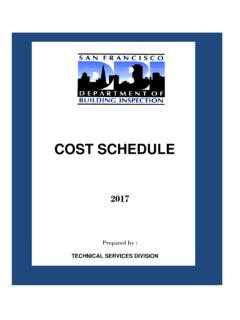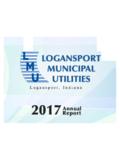Transcription of NEW YORK CITY 2017 DRINKING WATER SUPPLY AND ... - …
1 Bill de Blasio MayorVincent Sapienza, CommissionerNEW YORK CITY 2017 DRINKING WATER SUPPLY AND QUALITY REPORTN eversink ReservoirEsopusCreekShandaken Tunnel PENNSYLVANIANEW YORKNEW JERSEYCONNECTICUTCONNECTICUTNEW YORKMASSACHUSETTSNew YorkBayDelawareRiverHudson R iverLong Island SoundDelaware AqueductNew Cro ton Aqueduct DELAWARECOUNTYSCHOHARIECOUNTYGREENECOUNT YULSTERCOUNTYSULLIVANCOUNTYDUTCHESSCOUNT YORANGECOUNTYNASSAUCOUNTYCHENANGOCOUNTYO TSEGOCOUNTYALBANYCOUNTYRENSSELAERCOUNTYC OLUMBIACOUNTYPUTNAMCOUNTYROCKLANDCOUNTYW ESTCHESTERCOUNTYWest BranchReservoirNew Croton ReservoirKensico ReservoirNeversinkReservoirPepactonReser voirAshokanReservoirSchoharieReservoirRo ndoutReservoirCannonsvilleReservoirHudso n River HillviewReservoirNeversink River West BranchDelaware East BranchDelaware OneontaGilboaDepositLibertyKingstonPough keepsieEllenvilleWhitePlainsDelhiWaltonH unterPhoeniciaDownsvilleEast Delaware TunnelWest Delaware TunnelNeversinkTunnel25 Miles (from City Hall)
2 50 Miles 75 Miles 100 Miles 125 Miles CrotonWatershedCrotonWatershedAtlantic OceanCatskill/DelawareWatershedsCatskill /DelawareWatershedsEast BranchReservoirBog BrookReservoirCroton FallsReservoirBoyds CornerReservoirDivertingReservoirLakeGle neidaMuscootReservoirMiddleBranchReservo irTiticusReservoirAmawalkReservoirCross RiverReservoirLakeGileadKirkLakeCatskill Delaware Jerome ParkReservoirCity Tunnel No. 3 Silver Lake Park( underground Storage Tanks) ManhattannRichmond TunnelBrooklynStaten IslandBronxQueensCatskill Aqueduct BROOKLYNSTATENISLANDLong Island SoundEast RiverHudson RiverLowerNew YorkBayNEW YORK CITYWATER TUNNELS ANDDISTRIBUTION AREASNY City LineCatskill/Delaware WATER service areaCroton and Catskill/Delaware blended WATER service area Groundwater SUPPLY system (offline)Richmond TunnelCity Tunnel No. 3 City Tunnel No. 1 City Tunnel No. 2 HillviewReservoirBRONXMANHATTANJ erome ParkReservoirQUEENSS ilver Lake Park( underground Storage Tanks) New CrotonAqueductCity Tunnel No.
3 3 (Stage 2)Queens/Brooklyn Leg(Activation Ready)City Tunnel No. 1 MAP NOT TO SCALEC roton WaterFiltration PlantCity Tunnel No. 2 Croton WaterFiltration PlantCat/Del UV FacilityGilboa DamStaten Island SiphonDear Friends: On behalf of my nearly 6,000 colleagues at the Department of Environmental Protection (DEP), I am pleased to report that New York City continues to enjoy exceptionally high-quality tap WATER . As concerns over the safety of public WATER supplies remains high, I am proud that we continue to deliver more than 1 billion gallons of clean and delicious DRINKING WATER to nearly 10 million people every day. DEP marked several noteworthy achievements for New York City s WATER SUPPLY in 2017 . One of the most important was securing a new, 10-year Filtration Avoidance Determination (FAD) for the City's Catskill and Delaware WATER supplies. This important permit allows DEP to deliver 90 percent of the city s DRINKING WATER without filtration.
4 It also outlines a number of programs to keep our WATER clean at its source in the Hudson Valley and Catskill Mountains. These science-based programs in the FAD are rooted in the premise that it is most cost effective and environmentally sound to protect WATER at its natural source. The new filtration waiver is an endorsement of our programs, which are considered a worldwide model for protecting DRINKING WATER and the natural resources that preserve its quality. As part of the new FAD, DEP will commit an estimated $1 billion over the next decade to continue and expand many of these watershed initiatives. To ensure that these programs keep the WATER clean, DEP scientists collect WATER samples 365 days a year from our expansive reservoir system, the aqueducts that deliver the WATER to the city, and the roughly 1,000 street-side sampling stations spread across the five boroughs. Those WATER samples are delivered to one of DEP s four state-of-the-art laboratories where scientists analyze them more than 600,000 times annually.
5 Robotic monitoring buoys deployed on the reservoirs provide an additional million measurements that help us send the best WATER to the city at all times. The data from this extensive scientific analysis, which is outlined in this report, demonstrate that the City s WATER meets or exceeds all health and safety regulations. Keeping our WATER system in a state of good repair requires substantial investments. Last year we announced a $750 million program to upgrade nearly all the infrastructure at Ashokan Reservoir. The largest and most complex repair in the history of the WATER SUPPLY system, the $1 billion construction of the Delaware Aqueduct bypass tunnel, is on schedule as a tunnel boring machine has begun its work under the Hudson River. You will find details about this, and several other infrastructure projects, in the pages that follow. I am proud to present this report to the nearly 10 million New Yorkers who rely on us to deliver safe, clean, high-quality DRINKING WATER every day.
6 Sincerely, Vincent Sapienza, CommissionerVincent Sapienza, York City 2017 DRINKING WATER SUPPLY and Quality ReportNEW YORK CITY S WATER SUPPLY The New York City WATER SUPPLY System provides approximately one billion gallons of safe DRINKING WATER daily to more than million residents of New York City, and to the millions of tourists and commuters who visit the City throughout the year. The WATER SUPPLY system also provides about 110 million gallons a day to approximately one million people living in the counties of Westchester, Putnam, Orange, and Ulster. In all, the New York City WATER SUPPLY System provides nearly half the population of New York State with high-quality DRINKING DOES NEW YORK CITY S DRINKING WATER COME FROM?
7 New York City gets its DRINKING WATER from 19 reservoirs and three controlled lakes spread across a nearly 2,000-square-mile watershed. The watershed is not located in New York City, but rather upstate, in portions of the Hudson Valley and Catskill Mountains that are as far as 125 miles north of the City. A map of the watershed and reservoirs can be found on the inside of the front cover of this report. The New York City WATER SUPPLY System, Public WATER System Identification Number (PWSID) NY7003493, consists of three individual WATER supplies called the Catskill/Delaware SUPPLY , located in Delaware, Greene, Schoharie, Sullivan, and Ulster counties; the Croton SUPPLY , New York City s original upstate SUPPLY , in Putnam, Westchester, and Dutchess counties; and a groundwater SUPPLY in southeastern Queens. Although the Department of Environmental Protection (DEP) has a permit to operate the groundwater SUPPLY , WATER from that system has not been delivered to customers in many 2017 , New York City received a blend of DRINKING WATER from the Catskill/Delaware and Croton supplies.
8 The Catskill/Delaware SUPPLY provided approximately 97 percent of the WATER , and approximately three percent was supplied by Reservoir3 Croton WATER SUPPLY located in Putnam, Westchester, and Dutchess countiesThe Croton SUPPLY is filtered by the Croton WATER Filtration Plant, located underground in the Bronx. The plant has the ability to filter up to 290 million gallons of DRINKING WATER each day, which helps to ensure a sufficient SUPPLY of WATER for the City in the event of drought and increases the flexibility of New York City s SUPPLY against the potential effects of climate change. The Croton WATER Filtration Plant first began operating in May 2015. In 2017 , it was in operation from January 1 to February 28. No Croton WATER has been added to the distribution system since WATER is disinfected with chlorine which is a common disinfectant added to kill germs and stop bacteria from growing on pipes. Catskill/Delaware Ultraviolet (UV) Disinfection Facility It is the largest of its kind in the world located in Westchester County.
9 The facility is designed to disinfect more than 2 billion gallons of WATER per Distributionto the CustomerOtherTreatmentDisinfectionDisinf ection* During 2017 , only percent of the WATER produced by Catskill/Delaware SUPPLY was not fluoridated.** During 2017 , only percent of the WATER produced by the Croton WATER Filtration Plant was not fluoridated. Catskill/Delaware SUPPLY located in Delaware, Greene, Schoharie, Sullivan, and Ulster countiesDue to the very high quality of our Catskill/Delaware SUPPLY , New York City is one of only five large cities in the country with a surface DRINKING WATER SUPPLY that does not require filtration as a form of treatment. Rather, the Catskill/Delaware SUPPLY operates under a Filtration Avoidance Determination (FAD), and the WATER from the SUPPLY is treated using two forms of disinfection to reduce microbial DOES NEW YORK CITY TREAT ITS WATER SUPPLIES?UV Light At the UV Disinfection Facility exposure to UV light inactivates potentially harmful microorganisms.
10 UV treatment does not change the WATER chemically, as nothing is added except WATER Filtration PlantFiltrationChemicals are added to untreated WATER , causing particulates to bunch together and become larger particles called *Added to WATER to improve dental protection and is effective in preventing cavities at a federally approved level of Hydroxide Added to raise the pH and reduces corrosion of household Grade Phosphoric Acid Added because it creates a protective film on pipes that reduces the release of metals, such as lead, from service lines and household plumbing. DissolvedAir FlotationInjected air bubbles float the floc to the top where it is skimmed FiltrationThe WATER flows through a bed of sand removing any remaining LightChlorineFood Grade Phosphoric AcidSodium HydroxideFluoride**4 New York City 2017 DRINKING WATER SUPPLY and Quality ReportDRINKING WATER QUALITYREGULATION OF DRINKING WATERThe sources of DRINKING WATER (both tap WATER and bottled WATER ) include rivers, lakes, streams, ponds, reservoirs, springs, and wells.














